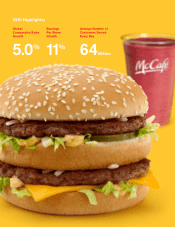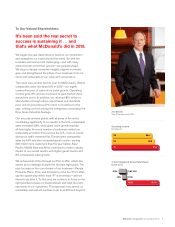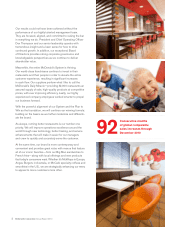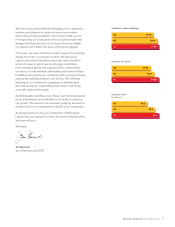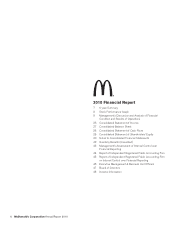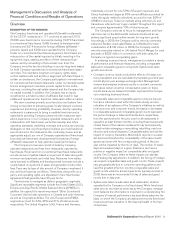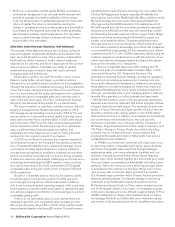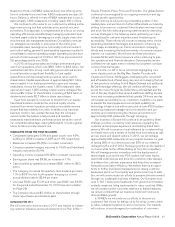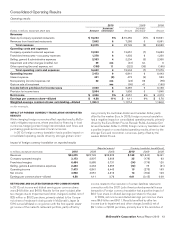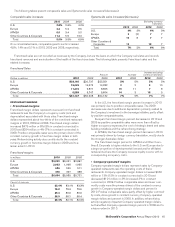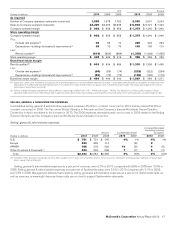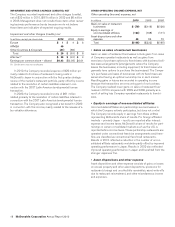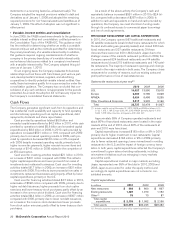McDonalds 2010 Annual Report Download - page 12
Download and view the complete annual report
Please find page 12 of the 2010 McDonalds annual report below. You can navigate through the pages in the report by either clicking on the pages listed below, or by using the keyword search tool below to find specific information within the annual report.• Return on incremental invested capital (ROIIC) is a measure
reviewed by management over one-year and three-year time
periods to evaluate the overall profitability of the business
units, the effectiveness of capital deployed and the future allo-
cation of capital. The return is calculated by dividing the
change in operating income plus depreciation and amortization
(numerator) by the adjusted cash used for investing activities
(denominator), primarily capital expenditures. The calculation
uses a constant average foreign exchange rate over the peri-
ods included in the calculation.
STRATEGIC DIRECTION AND FINANCIAL PERFORMANCE
The strength of the alignment among the Company, its franchi-
sees and suppliers (collectively referred to as the System) has
been key to McDonald’s success. This business model enables
McDonald’s to deliver consistent, locally-relevant restaurant
experiences to customers and be an integral part of the commun-
ities we serve. In addition, it facilitates our ability to identify,
implement and scale innovative ideas that meet customers’
changing needs and preferences.
McDonald’s customer-focused Plan to Win—which concen-
trates on being better, not just bigger—provides a common
framework for our global business yet allows for local adaptation.
Through the execution of initiatives surrounding the five elements
of our Plan to Win—People, Products, Place, Price and Promo-
tion—we have enhanced the restaurant experience for customers
worldwide and grown comparable sales and customer visits in
each of the last seven years. This Plan, combined with financial
discipline, has delivered strong results for our shareholders.
We have exceeded our long-term, constant currency financial
targets of average annual Systemwide sales growth of 3% to
5%; average annual operating income growth of 6% to 7%; and
annual returns on incremental invested capital in the high teens
every year since the Plan’s implementation in 2003, after adjust-
ing for the loss in 2007 from the Latin America developmental
license transaction. Given the size and scope of our global busi-
ness, we believe these financial targets are realistic and
sustainable over time, keeping us focused on making the best
decisions for the long-term benefit of our System.
In 2010, we continued to enhance the customer experience
by remaining focused on the Company’s key global success fac-
tors of branded affordability, menu variety and beverage choice,
convenience including daypart expansion, ongoing restaurant
reinvestment and operations excellence. Initiatives around these
factors successfully resonated with consumers driving increases
in sales and customer visits despite challenging economies and a
contracting Informal Eating Out (IEO) market in many countries.
As a result, every area of the world contributed to 2010 global
comparable sales and guest counts, which increased 5.0% and
4.9%, respectively.
Growth in comparable sales is driven by the System’s ability
to optimize guest count growth, product mix shifts and menu
price changes. Pricing actions reflect local market conditions,
with a view to preserving and improving margins, while continuing
to drive guest counts and market share gains. In general, the goal
is to achieve a balanced contribution of price and guest counts to
comparable sales growth.
In the U.S., we grew sales, guest counts, market share and
restaurant cash flow, with comparable sales increasing for the
8th consecutive year, rising 3.8% in 2010. These positive results
were achieved despite a declining IEO market. This performance
was attributed to several factors including core menu items like
Chicken McNuggets and burgers, everyday affordability and
value options, such as the Breakfast Dollar Menu, additions to the
McCafé beverage line, new snack offerings and limited time
offerings such as the McRib sandwich. The national launch of
McCafé frappés and real-fruit smoothies provided a meaningful
extension to the McCafé line that was well-received by custom-
ers. Extending the snack wrap line with the Angus Snack Wraps
allowed customers to enjoy popular McDonald’s burgers in a
smaller, more portable fashion. Complementing these menu
offerings were our convenient locations, efficient drive-thru serv-
ice and value-oriented local beverage promotions. We broadened
our accessibility through greater 24 hour operations and offered
customers free Wi-Fi in over 12,000 restaurants. Modernizing the
customer experience remained a focus with the extension of our
interior and exterior reimaging program to enhance the appear-
ance and functionality of our restaurants.
In Europe, comparable sales rose 4.4%, marking the 7th
consecutive year of comparable sales increases. Major contrib-
utors were France, the U.K., Russia and Germany. This
performance reflected Europe’s strategic priorities of upgrading
the customer and employee experience, increasing local rele-
vance, and building brand transparency. Initiatives surrounding
these platforms included leveraging our tiered menu featuring
everyday affordable prices, menu variety including limited-time
offerings, new dessert options, and reimaging almost 1,000 res-
taurants. We expanded our coffee business and have nearly
1,300 McCafé locations, which in Europe generally represent a
separate area inside the restaurant that serves specialty coffees,
indulgent desserts and light snacks. The expansion of self-order
kiosks in France, Germany and Spain and the roll out of the new
drive-thru customer order display system in over 3,000 restau-
rants enhanced service. In addition, we increased our accessibility
and convenience with extended hours. We built upon the
momentum of portable menu offerings with the introduction of
McWraps—larger sized beef and chicken wraps in Germany, and
P’tit Plaisir offerings in France. Finally, we continued building
customer trust in our brand through communications that
emphasized the quality and origin of McDonald’s food and our
sustainable business initiatives.
In APMEA, our momentum continued with nearly every coun-
try delivering positive comparable sales, led by Japan, Australia
and China. Comparable sales rose 6.0% through strategies
emphasizing value, core menu extensions, breakfast and con-
venience. Australia launched Family Dinner Boxes featuring
popular menu items bundled together at a discounted price while
China and Japan concentrated on affordability with Value Lunch
platforms. New menu items such as a third Angus burger option
in Australia and the extension of the Spicy Wings line in China
were popular with consumers. Japan executed a successful
U.S.-themed burger promotion and a Chicken Festival promotion
featuring several products. Our dessert strategy is introducing
consumers to the McDonald’s brand with products such as
McFlurries and dessert kiosks in China, where we have become
one of the largest retailers of ice cream. Our breakfast business
continues to develop and is now offered in approximately 75% of
APMEA restaurants. In Japan, value breakfast items, including
the Sausage McMuffin and McGriddle, were rotated across sev-
eral months, while Australia launched new breakfast menu items.
10 McDonald’s Corporation Annual Report 2010


